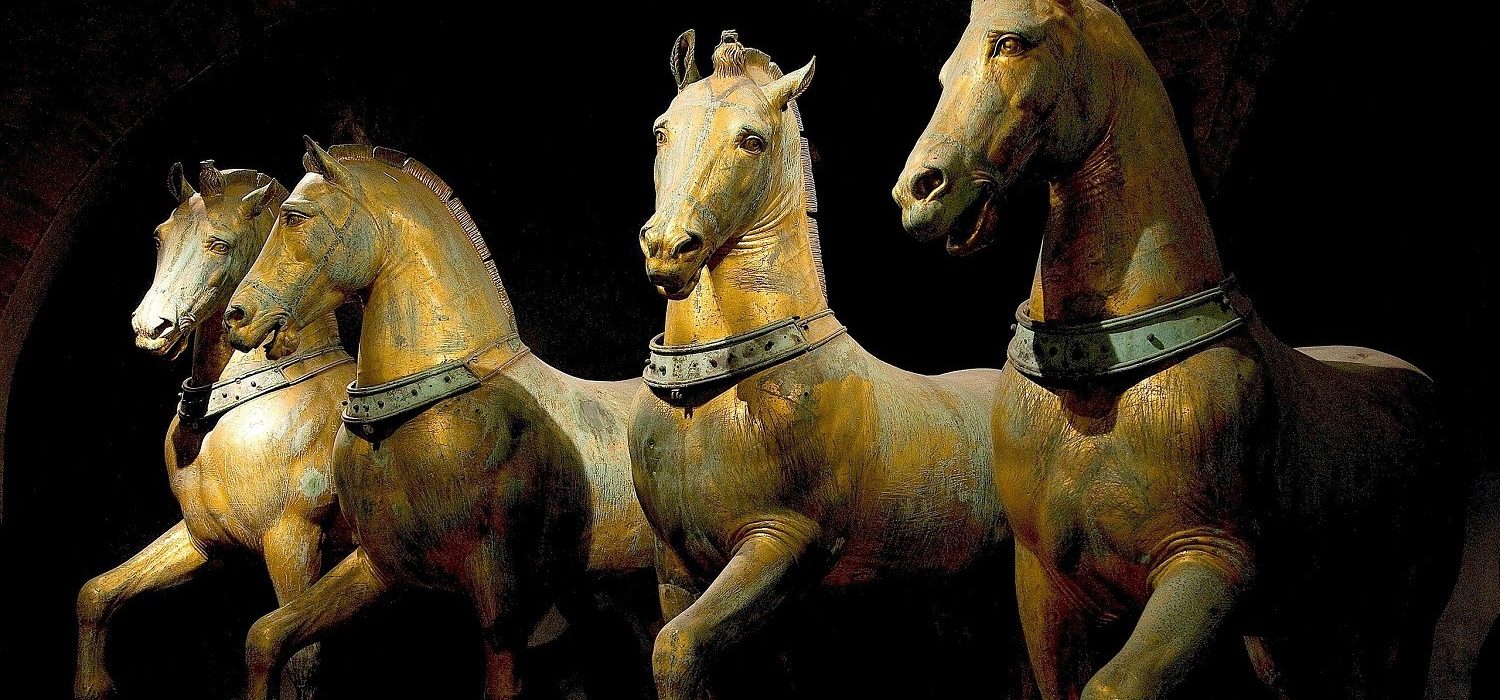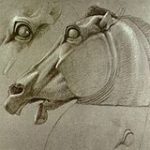The Horses of San Marco
By Tom Parsons
16th June 2021 6pm
The Horses of San Marco that overlook the Piazza, above the main entrance arch to the most splendid and important of Venice’s churches, are replicas. The originals stand now inside, in a rather dark corner on an upper floor, moved here in the 1980s to preserve them from atmospheric pollution. It’s rather an unprepossessing spot for sculptures with such an illustrious history but at least it’s normally quite quiet, not crowded, and conducive, if you’re so minded, for a quick chat.
All four trot or walk with animated stride, expressive faces, ears erect, open mouthed, carefully coiffured. Skin ruckles on their necks and where foreleg meets chest, veins bulge above the knees and nostrils. The chariot and rider they used to pull, many centuries ago and long lost, would have moved at a jaunty, perky pace.
What stories they could tell, if they could speak. No one knows for sure when they were made: but we do know they were in Rome, possibly in the Forum or the Stadium of Domitian (now the Piazza Navona) at the height of her empire. In the 4th century AD the first Christian emperor, Constantine, took them to his new capital, Constantinople, where they stood above the Hippodrome, within sight of the imperial palace and, a couple of hundred years later, the construction of the Hagia Sophia. In 1204 they were stolen by the Venetians and placed on the façade of San Marco as trophies celebrating Venice’s naval and economic hegemony over the East. There they remained until Venice fell to Napoleon in 1796, whereupon he took them to Paris to sit on top of the Arc du Carrousel outside the Louvre. Twenty years later, after Waterloo, British engineers returned them to Venice. They had a brief holiday back in Rome during the First World War where they were taken for safekeeping before returning again to St Mark’s.
So much of our history, then, is bound up with them: in many ways they are our history. Classical and Christian Rome, out of whose ruins medieval and Renaissance Europe emerged, followed by the bloody birth of our modern nation states – they’ve seen or heard it all. For one thing, while they were outside, they’d have heard Monteverdi’s Vespers seeping out from the choir as the sun set over the lagoon. And consider how many different languages they’ve listened to through the centuries: in their earlier lives Latin, both golden and silver, in Rome, and Greek in Constantinople; then in Venice the former’s transformation into Italian, alongside the guttural accents of the Venetian dialect, the polyglot languages of the medieval world’s merchants haggling in the piazza below; and French, briefly, in post-revolutionary Paris and then the German and English of the first tourists, Goethe’s lyrical eulogies to the republic, the aristocratic accents of Shelley and Byron taking coffee in one of the cafés or, a few years later, Hemingway’s ramblings dimly audible from the doors of Harry’s Bar. I wonder how many words or phrases they began to recognise, and remember.
To Purchase a recording
A link to the recording is available for £15.60 via Tixoom and is valid for one week after payment. Please follow the link below and then select the blue button ‘Get Your Ticket’
Click here to Purchase a Recording
Please note you may need to check your junk folder for the link
Please contact [email protected] if you have any queries
A catch-up recording is now available to everyone who buys a ticket. You will have 1 week after the lecture date to watch the lecture recording even if you saw the live lecture also. There is now no need to let me know if you would like a recording – just login in to My Tickets at Tixoom https://tixoom.app/mytickets and you can access the recording automatically for 1 week only. The recording will be available by Thursday evening.





